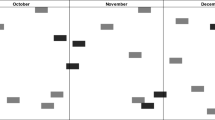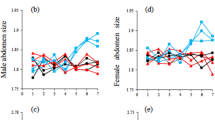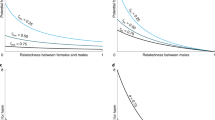Abstract
Resolving the strategies by which organisms compete for limited resources is key to understanding behavioural and social evolution. When competing for matings, males in many species allocate mating effort preferentially towards higher-quality females. How males balance this against avoiding competition with rival males, who should also prefer high-quality females, is poorly understood. Kin selection theory further complicates these dynamics: males should avoid competition with close relatives especially because of added, indirect fitness costs. However, whether between-male relatedness modulates the intensity of intrasexual competition is equivocal. Here, we develop and test an analytical model describing how males should optimally allocate their mating efforts in response to information about differences in female quality, competitor presence/absence and competitor relatedness. Using freely interacting groups of Trinidadian guppies (Poecilia reticulata), we show concordance between observed and predicted mating effort allocation across all combinations of these factors. Thus, male mating effort is sensitive to variation in female quality, competitor presence and competitor relatedness, which is consistent with a kin-selected strategy of male–male competition. The fit of our model’s predictions demonstrates that males integrate assessments of female quality and competitive context in a quantitatively meaningful way, implicating a competitive strategy that has been fine-tuned to maximize inclusive fitness gains.
This is a preview of subscription content, access via your institution
Access options
Access Nature and 54 other Nature Portfolio journals
Get Nature+, our best-value online-access subscription
$29.99 / 30 days
cancel any time
Subscribe to this journal
Receive 12 digital issues and online access to articles
$119.00 per year
only $9.92 per issue
Buy this article
- Purchase on Springer Link
- Instant access to full article PDF
Prices may be subject to local taxes which are calculated during checkout



Similar content being viewed by others
Data availability
Data supporting this study are available as Excel spreadsheets as part of the Supplementary Data.
Code availability
The source code for the simulated behavioural trials can be found at https://github.com/williarj/GuppySim2017.
References
Edward, D. A. & Chapman, T. The evolution and significance of male mate choice. Trends Ecol. Evol. 26, 647–654 (2011).
West-Eberhard, M. J. Sexual selection, social competition, and evolution. Proc. Am. Phil. Soc. 123, 222–234 (1979).
Rowell., J. T. & Servedio, M. R. Gentlemen prefer blondes: the evolution of mate preference among strategically allocated males. Am. Nat. 173, 12–25 (2009).
Venner, S., Bernstein, C., Dray, S. & Bel-Venner, M.-C. Make love not war: when should less competitive males choose low-quality but defendable females? Am. Nat. 175, 650–661 (2010).
Wedell, N., Gage, M. J. & Parker, G. A. Sperm competition, male prudence and sperm-limited females. Trends Ecol. Evol. 17, 313–320 (2002).
Härdling, R., Gosden, T. & Aguilée, R. Male mating constraints affect mutual mate choice: prudent male courting and sperm-limited females. Am. Nat. 172, 259–271 (2008).
Wild, G., Pizzari, T. & West, S. A. Sexual conflict in viscous populations: the effect of the timing of dispersal. Theor. Popul. Biol. 80, 298–316 (2011).
Carazo, P., Tan, C. K. W., Allen, F., Wigby, S. & Pizzari, T. Within-group male relatedness reduces harm to females in Drosophila. Nature 505, 672–675 (2014).
Chippindale, A. K., Berggren, M., Alpern, J. H. M. & Montgomerie, R. Does kin selection moderate sexual conflict in Drosophila? Proc. Biol. Sci. 282, 20151417 (2015).
Hollis, B., Kawecki, T. J. & Keller, L. No evidence that within‐group male relatedness reduces harm to females in Drosophila. Ecol. Evol. 5, 979–983 (2015).
Martin, E. S. & Long, T. A. F. Are flies kind to kin? The role of intra- and inter-sexual relatedness in mediating reproductive conflict. Proc. Biol. Sci. 282, 20151991 (2015).
Le Page, S. et al. Male relatedness and familiarity are required to modulate male-induced harm to females in Drosophila. Proc. Biol. Sci. 284, 20170441 (2017).
Lymbery, S. J. & Simmons, L. W. Males harm females less when competing with familiar relatives. Proc. Biol. Sci. 284, 20171984 (2017).
Daniel, M. J. & Rodd, F. H. Female guppies can recognize kin but only avoid incest when previously mated. Behav. Ecol. 27, 55–61 (2016).
Hamilton, W. D. The genetical evolution of social behaviour. II. J. Theor. Biol. 7, 17–52 (1964).
West, S. A. & Gardner, A. Altruism, spite, and greenbeards. Science 327, 1341–1344 (2010).
Staddon, J. E. R. Adaptive Behavior and Learning (Cambridge Univ. Press, 1983).
Sargent, R. C., Gross, M. R. & Van Den Berghe, E. P. Male mate choice in fishes. Anim. Behav. 34, 545–550 (1986).
Price, A. C. & Rodd, F. H. The effect of social environment on male–male competition in guppies (Poecilia reticulata). Ethology 112, 22–32 (2006).
Houde, A. E. Sex, Color, and Mate Choice in Guppies (Princeton Univ. Press, 1997).
Dosen, L. D. & Montgomerie, R. Female size influences mate preferences of male guppies. Ethology 110, 245–255 (2004).
Hain, T. J. A. & Neff, B. D. Multiple paternity and kin recognition mechanisms in a guppy population. Mol. Ecol. 16, 3938–3946 (2007).
Farr, J. A. Male rarity or novelty, female choice behavior, and sexual selection in the guppy, Poecilia reticulata Peters (Pisces: Poeciliidae). Evolution 31, 162–168 (1977).
Hughes, K. A., Du, L., Rodd, F. H. & Reznick, D. N. Familiarity leads to female mate preference for novel males in the guppy, Poecilia reticulata. Anim. Behav. 58, 907–916 (1999).
Eakley, A. L. & Houde, A. E. Possible role of female discrimination against ‘redundant’ males in the evolution of colour pattern polymorphism in guppies. Proc. Biol. Sci. 271, S299–S301 (2004).
Zajitschek, S. R. & Brooks, R. C. Distinguishing the effects of familiarity, relatedness, and color pattern rarity on attractiveness and measuring their effects on sexual selection in guppies (Poecilia reticulata). Am. Nat. 172, 843–854 (2008).
Hampton, K. J., Hughes, K. A. & Houde, A. E. The allure of the distinctive: reduced sexual responsiveness of female guppies to ‘redundant’ male colour patterns. Ethology 115, 475–481 (2009).
Hughes, K. A., Houde, A. E., Price, A. C. & Rodd, F. H. Mating advantage for rare males in wild guppy populations. Nature 503, 108–110 (2013).
Graber, R. E., Senagolage, M., Ross, E., Houde, A. E. & Hughes, K. A. Mate preference for novel phenotypes: a fresh face matters. Ethology 121, 17–25 (2015).
Daniel, M. J., Koffinas, L. & Hughes, K. A. Habituation underpins preference for mates with novel phenotypes in the guppy. Proc. Biol. Sci. 286, 20190435 (2019).
Mann, K. D., Turnell, E. R., Atema, J. & Gerlach, G. Kin recognition in juvenile zebrafish (Danio rerio) based on olfactory cues. Biol. Bull. 205, 224–225 (2003).
Mehlis, M., Bakker, T. C. M. & Frommen, J. G. Smells like sib spirit: kin recognition in three-spined sticklebacks (Gasterosteus aculeatus) is mediated by olfactory cues. Anim. Cogn. 11, 643–650 (2008).
Olsén, K. H. in Fish Chemoreception (ed. Hara, T. J.) Ch. 11 (Springer, 1992).
Griffiths, S. W. & Magurran, A. E. Familiarity in schooling fish: how long does it take to acquire? Anim. Behav. 53, 945–949 (1997).
Mariette, M. M., Zajitschek, S. R. K., Garcia, C. M. & Brooks, R. C. The effects of familiarity and group size on mating preferences in the guppy, Poecilia reticulata. J. Evol. Biol. 23, 1772–1782 (2010).
Piyapong, C. et al. Kin assortment in juvenile shoals in wild guppy populations. Heredity (Edinb) 106, 749–756 (2011).
Villinger, J. & Waldman, B. Self-referent MHC type matching in frog tadpoles. Proc. Biol. Sci. 275, 1225–1230 (2008).
Mateo, J. M. Self-referent phenotype matching and long-term maintenance of kin recognition. Anim. Behav. 80, 929–935 (2010).
Neff, B. D. & Sherman, P. W. In vitro fertilization reveals offspring recognition via self‐referencing in a fish with paternal care and cuckoldry. Ethology 111, 425–438 (2005).
Hain, T. J. A. & Neff, B. D. Promiscuity drives self-referent kin recognition. Curr. Biol. 16, 1807–1811 (2006).
Gerlach, G., Hodgins-Davis, A., Avolio, C. & Schunter, C. Kin recognition in zebrafish: a 24-hour window for olfactory imprinting. Proc. Biol. Sci. 275, 2165–2170 (2008).
Bisazza, A., Novarini, N. & Pilastro, A. Male body size and male–male competition: interspecific variation in poeciliid fishes. Ital. J. Zool. 63, 365–369 (1996).
Horth, L. Melanic body colour and aggressive mating behaviour are correlated traits in male mosquitofish (Gambusia holbrooki). Proc. Biol. Sci. 270, 1033–1040 (2003).
Paterson, I. G., Crispo, E., Kinnison, M. T., Hendry, A. P. & Bentzen, P. Characterization of tetranucleotide microsatellite markers in guppy (Poecilia reticulata). Mol. Ecol. Notes 5, 269–271 (2005).
Van Oosterhout, C., Hutchinson, W. F., Wills, D. P. & Shipley, P. micro‐checker: software for identifying and correcting genotyping errors in microsatellite data. Mol. Ecol. Notes 4, 535–538 (2004).
Jones, A. G. gerud 2.0: a computer program for the reconstruction of parental genotypes from half‐sib progeny arrays with known or unknown parents. Mol. Ecol. Notes 5, 708–711 (2005).
Sefc, K. M. & Koblmüller, S. Assessing parent numbers from offspring genotypes: the importance of marker polymorphism. J. Hered. 100, 197–205 (2009).
Pitcher, T. E., Neff, B. D., Rodd, F. H. & Rowe, L. Multiple mating and sequential mate choice in guppies: females trade up. Proc. Biol. Sci. 270, 1623–1629 (2003).
Rousset, F. & Billiard, S. A theoretical basis for measures of kin selection in subdivided populations: finite populations and localized dispersal. J. Evol. Biol. 13, 814–825 (2000).
Krupp, D. B. & Taylor, P. D. Enhanced kin recognition through population estimation. Am. Nat. 181, 707–714 (2013).
Queller, D. C. Genetic relatedness in viscous populations. Evol. Ecol. 8, 70–73 (1994).
R Core Team R: A Language and Environment for Statistical Computing (R Foundation for Statistical Computing, 2018); https://www.R-project.org/
Oksanen, J. et al. vegan: Community Ecology Package. R package version 2.4-5 https://cran.r-project.org/web/packages/vegan/index.html (2017).
Legendre, P., Legendre, L. Numerical Ecology (Elsevier, 2012).
Huang, Y., Xu, H., Calian, V. & Hsu, J. C. To permute or not to permute. Bioinformatics 22, 2244–2248 (2006).
Acknowledgements
We thank A. De Serrano, A. Li and many undergraduate assistants for their help in rearing the fish. A. De Serrano, A. Li, L. Rowe, D. McLennan, A. Agrawal, J. Levine, D. Punzalan, F. H. Rodd, K. Hughes and A. Wardlaw provided comments on our experimental design, model and/or analyses. T. Paton, T. Harrison and S. Wright assisted with genotyping. We also thank I. Ramnarine and the Government of Trinidad and Tobago for permission to collect the guppies. This work was supported by funding from the National Sciences and Engineering Research Council to M.J.D. (grant no. CGSM-427283-2012).
Author information
Authors and Affiliations
Contributions
M.J.D. designed the experiment and analytical model, and conducted and analysed the behavioural and molecular work. R.J.W. designed the individual-based model. M.J.D. wrote the article with input from R.J.W.
Corresponding author
Ethics declarations
Competing interests
The authors declare no competing interests.
Additional information
Publisher’s note Springer Nature remains neutral with regard to jurisdictional claims in published maps and institutional affiliations.
Supplementary information
Supplementary Information
Supplementary Methods, discussion, Figs. 1–6 and Tables 1–6.
Supplementary Data
Excel spreadsheets containing the data supporting the article’s empirical experiments: (1) wild-caught female profitabilities, (2) male–male relatedness behavioural experiment and (3) male colour pattern behavioural experiment.
Rights and permissions
About this article
Cite this article
Daniel, M.J., Williamson, R.J. Males optimally balance selfish and kin-selected strategies of sexual competition in the guppy. Nat Ecol Evol 4, 745–752 (2020). https://doi.org/10.1038/s41559-020-1152-3
Received:
Accepted:
Published:
Issue Date:
DOI: https://doi.org/10.1038/s41559-020-1152-3
This article is cited by
-
Extrinsic stressors modulate resource evaluations: insights from territoriality under artificial noise
Frontiers in Zoology (2021)



